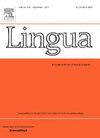儿童遗产西班牙语中虚拟语气的产生:早期习得语境的考察
IF 1.3
3区 文学
0 LANGUAGE & LINGUISTICS
引用次数: 0
摘要
本研究考察了30名传统儿童、30名单语儿童、15名移民父母和15名单语父母在两种不同选择类型的早期习得义务谓语(意愿谓语和报告命令谓语,包括询问者“想要”和指示者“说/告诉”)中虚拟语气的产生。此外,本研究还探讨了实足年龄、熟练程度、语言暴露和语言使用对虚拟语气产生的影响。通过完成句子任务获得的结果显示,传统儿童使用虚拟语气的比例很高。尽管如此,遗产儿童在产生替代反应方面与其他群体不同。结果还显示,实足年龄和熟练程度对虚拟语气使用概率的影响显著。孩子越熟练,年龄越大,他们使用虚拟语气的次数就越多。个别结果显示,儿童的表现存在差异,一些儿童表现出对虚拟语气的绝对使用,而另一些儿童表现出对虚拟语气的可变使用。该研究认为,长期发展源于年龄和熟练程度之间的相互作用。它还强调了在形态句法习得中考虑个体差异的重要性,因为这种差异反映了双语发展的动态和个性化。本文章由计算机程序翻译,如有差异,请以英文原文为准。
The production of the subjunctive in child heritage Spanish: an examination of early acquired contexts
The present study examined the production of the subjunctive among 30 child heritage speakers, 30 monolingual children, 15 immigrant parents and 15 monolingual parents in two early acquired deontic predicates that differ in selection type (predicates of volition and reported commands, including querer “to want” and decir “to say/tell”). Additionally, it explored the role of chronological age, proficiency, language exposure and language use on the production of the subjunctive. The results obtained via a sentence completion task showed high rates of subjunctive use among the heritage children. Nonetheless, the heritage children differed from the other groups in the production of alternative responses. Results also showed a significant role of chronological age and proficiency in the probability of subjunctive use. The more proficient and the older the children were, the more they produced the subjunctive. Individual results showed variability in the children’s performance with some children exhibiting categorical use of the subjunctive and others showing variable use of it. The study argues for protracted development stemming from the interaction between age and proficiency. It also highlights the importance of considering individual variability in morphosyntactic acquisition, as such variability reflects the dynamic and individualized nature of bilingual development.
求助全文
通过发布文献求助,成功后即可免费获取论文全文。
去求助
来源期刊

Lingua
Multiple-
CiteScore
2.50
自引率
9.10%
发文量
93
审稿时长
24 weeks
期刊介绍:
Lingua publishes papers of any length, if justified, as well as review articles surveying developments in the various fields of linguistics, and occasional discussions. A considerable number of pages in each issue are devoted to critical book reviews. Lingua also publishes Lingua Franca articles consisting of provocative exchanges expressing strong opinions on central topics in linguistics; The Decade In articles which are educational articles offering the nonspecialist linguist an overview of a given area of study; and Taking up the Gauntlet special issues composed of a set number of papers examining one set of data and exploring whose theory offers the most insight with a minimal set of assumptions and a maximum of arguments.
 求助内容:
求助内容: 应助结果提醒方式:
应助结果提醒方式:


